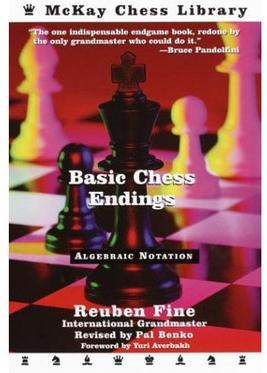
After starting his pro career in 1932, Reuben Fine (1914-1993) had a claim to being the best player in the world during the late 1930s. He won a string of elite tournaments including Hastings 1935/36, Zandvoort 1936, Amsterdam 1936 (tied with World Champion Max Euwe), Margate 1937 (tied with Paul Keres), and AVRO 1938 (also tied with Keres). AVRO is considered one of the strongest tournaments ever held. World Champion Magnus Carlsen also rates Fine very highly.
Fine wrote Basic Chess Endings in 1941, and it covered endings of just about every type. BCE was a monumental work at a time when endgame books were scarce, especially one authored by a player of Fine’s caliber.
Unfortunately, such an extensive book published in the pre-computer era had errors and was notoriously tough to slog through. It was also written in Descriptive Notation (P—K4, Kt—KB3, etc.), which put many readers off.
So in 2003, Random House published a new edition revised by Pal Benko (1928-2019), former world championship candidate and renowned endgame expert. It also includes a forward by another renowned endgame authority, Yuri Averbakh. This version of BCE was written in algebraic notation (e4, Nf3, etc.) and is much easier to read.
What I like about Basic Chess Endings
The explanations are very well done; but many contemporary books could say the same.
What sets BCE apart is the sheer number of instructive examples: 1,131 in all. Not all of them have diagrams; often, just the positions of the white and black pieces are listed and the line of play given. But these are supplemental examples, and never the main teaching positions.
Too many endgame books skimp on the number of examples, especially positions with several pawns for each side. Another favorite endgame book of mine is A Guide to Chess Endings by Euwe and David Hooper, which contains only 331 examples. That one is a pocket guide, but still.
What I don’t like about Basic Chess Endings
My only complaint is that a hardcover edition isn’t available. A softcover reference book 586 pages long? I try to be very careful with my copy. Economics were surely a factor; most readers wouldn’t shell out $40+ for a hardcover edition, but couldn’t they have done a limited run?
Study suggestion
I recommend picking a section and working through all of the examples. Not all of “Knight endings” in one sitting, but a section, e.g. “One Knight and Pawns vs. One Knight and Pawns — Material Advantage.” Pick a section and work through the examples — you’ll learn exactly how you should play similar positions.
